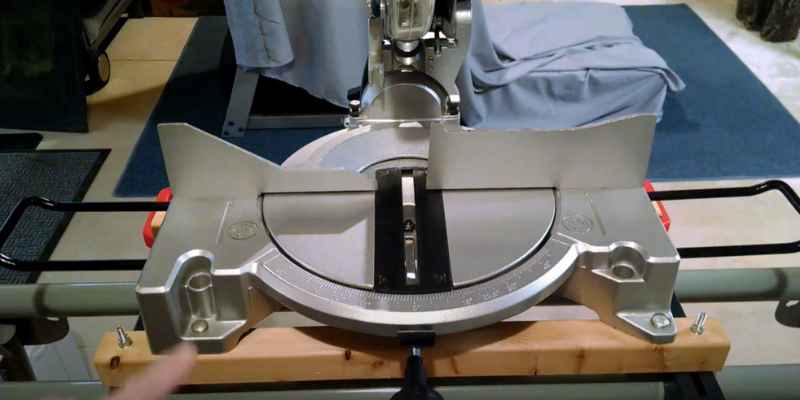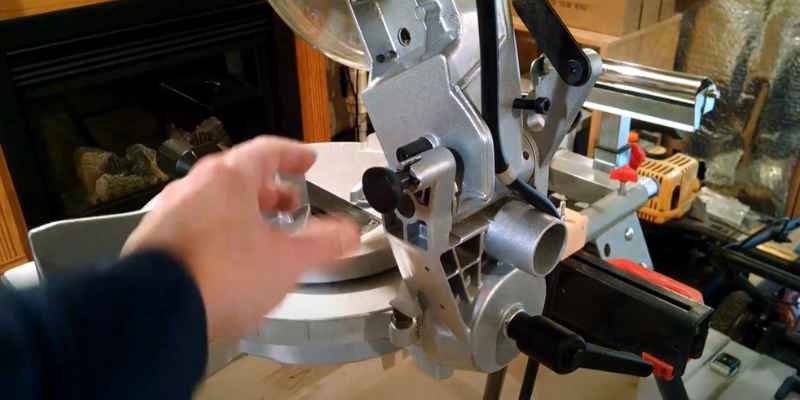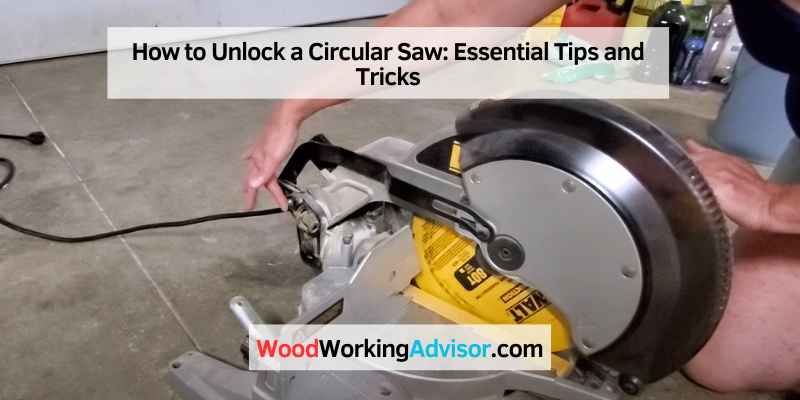To unlock a circular saw, locate the blade lock button or lever and press or slide it. Then, rotate the blade until it is locked in place.
Unlocking a circular saw is a simple process that can be done in just a few steps. By following these steps, you can safely and efficiently unlock your circular saw and get back to your cutting tasks. Whether you are a professional contractor or a DIY enthusiast, knowing how to unlock your circular saw is essential for ensuring its proper operation and maintenance.
We will guide you through the steps to unlock a circular saw so that you can continue using this versatile power tool with ease and confidence.
Safety Precautions
To unlock a circular saw, first, ensure the tool is switched off and unplugged. Then, locate the blade lock button, press it and rotate the blade until it locks in place. Use a wrench to loosen the arbor nut, remove the blade, and replace it with the new one, tightening the nut securely before use.
Wearing Protective Gear
Wearing the appropriate protective gear is essential when working with a circular saw. This helps safeguard you from any potential injuries. Here’s a list of protective gear you should wear:
- Safety goggles: Protect your eyes from flying debris and ensure clear vision.
- Ear defenders: Reduce the noise level produced by the saw, preventing hearing damage.
- Dust mask: Prevent inhalation of sawdust, keeping your respiratory system safe.
- Work gloves: Provide a better grip and protect your hands from cuts or grazes.
- Steel-toe boots: Offer foot protection from heavy materials and falling objects.
Checking For Power Source
Before you unlock a circular saw, it is crucial to check its power source. Make sure to follow these steps:
- Remove the saw’s power cord from the wall socket if it is electrically powered.
- If using a battery-operated saw, ensure the battery is disconnected.
- For corded saws, examine the power cord for any visible damage or fraying.
- If the saw is powered by a battery, check if it has adequate charge.

Understanding Your Circular Saw
Before you begin using your circular saw, it’s essential to have a good understanding of its components and the different types of blades available. By familiarizing yourself with these aspects, you will be better equipped to unlock the full potential of your tool and achieve accurate and efficient cuts. Let’s dive into the details!
Components Overview
Your circular saw consists of various components that work together to provide you with a reliable cutting experience. Understanding each component will enable you to troubleshoot any issues that may arise and maintain your saw in top condition. Here’s an overview of the key components:
- Motor: The motor is the heart of your circular saw. It provides the power needed to spin the blade and make the cuts. Make sure to choose a circular saw with a motor powerful enough for your cutting needs.
- Blade: The blade is the business end of the saw. It comes in various sizes and types, each designed for specific materials and cutting applications. We’ll discuss the different blade types in the next section.
- Base Plate: Also known as the shoe or sole plate, the base plate is the flat, sturdy surface that rests on the material being cut. Its main purpose is to provide stability and support during the cutting process.
- Guard: The guard is a safety feature that covers the blade when it’s not in use. It retracts automatically as you push the saw forward and covers the blade again once the cut is complete. Always ensure the guard is functioning properly before using your circular saw.
- Handle: The handle provides a comfortable grip and allows you to control the saw during operation. Make sure to hold the handle firmly and maintain a secure grip at all times to prevent accidents.
- Depth Adjustment: The depth adjustment allows you to set the cutting depth of the blade. It ensures that the blade does not protrude too far below the material, reducing the risk of accidents and improving cut accuracy.
Blade Types
The type of blade you choose for your circular saw depends on the material you’re cutting and the desired result. Different blade types have specific tooth configurations and are designed to cut through various materials effectively. Here are some common blade types:
| Blade Type | Best Used For |
|---|---|
| 1. Rip-Cut Blade | Cutting along the grain of the wood |
| 2. Crosscut Blade | Cutting across the grain of the wood |
| 3. Plywood Blade | Cutting plywood and other sheet goods |
| 4. Melamine Blade | Cutting melamine and laminates without chipping or splintering |
| 5. Metal Cutting Blade | Cutting through various metals |
By selecting the right blade for the job, you can maximize the performance of your circular saw and achieve cleaner and more precise cuts. Make sure to choose the appropriate blade type based on your specific cutting requirements.
Unlocking Techniques
Unlocking a circular saw is essential for adjusting the cutting depth and ensuring a smooth and precise cut. There are various techniques to unlock a circular saw, and understanding them can significantly enhance your woodworking experience.
Release Mechanism
To unlock a circular saw, locate the release lever or button usually positioned near the cutting depth adjustment knob. Firmly press or pull the lever to disengage the lock. Once released, the saw blade can be adjusted to the desired depth for your cutting task.
Adjusting Cutting Depth
After unlocking the circular saw, adjusting the cutting depth is crucial for controlling the depth of the cut into the workpiece. Turn the depth adjustment knob clockwise to increase the cutting depth and counterclockwise to decrease it. Ensure the depth is appropriate for the material you are cutting to achieve precision and safety.
Maintenance
Unlocking a circular saw is an essential maintenance task. Follow these simple steps to ensure your saw is ready for use without any hiccups.
Maintenance is an essential part of prolonging the lifespan and ensuring the optimal performance of your circular saw. By regularly inspecting the blade and keeping it properly lubricated, you can keep your circular saw in top-notch shape. In this section, we will discuss the important aspects of maintenance that every circular saw owner should be aware of.
Blade Inspection
Inspecting the blade of your circular saw is crucial for both your safety and the efficiency of your tool. Before using your saw, you should carefully examine the condition of the blade to make sure it is in good shape. Here are some key points to consider during the blade inspection:
- Check for any signs of wear and tear, such as missing or chipped teeth.
- Ensure the blade is securely in place and not loose.
- Look for any warping or bending of the blade, as this can affect the accuracy of your cuts.
- Inspect the blade for any build-up of debris or resin that could hinder its performance.
By taking the time to inspect your circular saw blade before each use, you can identify any potential issues and address them promptly. This will not only improve the quality of your cuts but also increase the safety of your working environment.
Lubrication
Proper lubrication is essential to ensure smooth operation and prevent premature wear of your circular saw. Here are some key points to consider when it comes to lubrication:
| Lubrication Points | Frequency | Lubricant |
|---|---|---|
| Arbor | After 10 hours of use | Light machine oil |
| Elevation/guides | Monthly | Lithium grease |
- Apply a few drops of light machine oil to the arbor of your circular saw after every 10 hours of use to ensure smooth rotation.
- Regularly lubricate the elevation mechanisms and guides with lithium grease to prevent friction and maintain accurate cuts.
Remember to always refer to your circular saw’s user manual for specific lubrication instructions, as different models may have varying requirements. By following the recommended lubrication schedule, you can keep your circular saw operating at its best and extend its overall lifespan.
Troubleshooting
Having trouble unlocking your circular saw? Don’t worry, we’ve got you covered! In this troubleshooting guide, we’ll explore common issues that could be preventing your circular saw from unlocking. By identifying and addressing these problems, you’ll be back to using your saw in no time.
Blade Alignment Issues
If your circular saw is not unlocking, the culprit could be blade alignment issues. When the blade is not properly aligned, it can put pressure on the locking mechanism, making it difficult to release. Here’s what you can do to fix the problem:
- Ensure the saw is unplugged or the battery is removed for safety.
- Inspect the blade for any signs of misalignment or damage. If the blade is bent or the teeth are dull, it may need to be replaced.
- Loosen the blade bolt with a wrench and reposition the blade so that it is parallel to the saw’s base plate. Tighten the blade bolt securely.
- Check the blade guard to ensure it is not obstructing the blade or impeding its movement. Adjust or remove the blade guard if necessary.
- Test the unlocking mechanism to see if the blade can now be released. If not, continue to the next section for further troubleshooting.
Motor Problems
If addressing blade alignment issues did not solve the unlocking problem, it’s possible that there are motor-related problems preventing the saw from releasing the blade. Here are a few steps you can take to troubleshoot motor issues:
- Make sure the saw is turned off and unplugged, or the battery is removed.
- Inspect the motor housing for any signs of damage, such as cracks or loose wires. If any issues are detected, it may be necessary to consult a professional for repair or replacement.
- Check for any debris or sawdust that may have accumulated around the motor. Use a brush or compressed air to clean out any obstructions.
- Inspect the power cord or battery connections to ensure they are firmly connected and free from damage.
- If you have access to the saw’s manual, refer to it for any specific troubleshooting instructions or contact the manufacturer for further assistance.
By addressing blade alignment and motor-related issues, you should be able to successfully unlock your circular saw. If the problem persists or you are unsure about performing any troubleshooting steps, it is always recommended to seek professional help or contact the manufacturer for support.

Frequently Asked Questions On How To Unlock A Circular Saw
How Do You Unlock A Power Saw?
To unlock a power saw, locate the lock button or switch near the handle. Press or slide it to release the lock and enable the saw. Always follow the manufacturer’s instructions for your specific model to ensure safe operation.
How Do You Unlock A Ryobi Circular Saw?
To unlock a Ryobi circular saw, locate the release lever near the blade guard. Press the lever to release the guard and adjust the cutting depth. Lift the guard until it locks into place, ready for use. Always follow the manufacturer’s instructions for safety.
How Do You Unlock A Dewalt?
To unlock a Dewalt, follow these steps:
1. Locate the power switch or lock button.
2. Press and hold the lock button or flip the power switch to the unlock position.
3. Release the button or switch once unlocked.
4.Ensure the tool is safely used and handled.
5. Refer to the user manual for more detailed instructions.
How Do You Unlock A Hitachi Chop Saw?
To unlock a Hitachi chop saw, locate the locking lever and slide it to the “unlock” position. Then, release the lever and ensure it locks into place. This will allow the saw to move freely and be ready for use.
Conclusion
Unlocking a circular saw is an essential skill for any woodworking enthusiast. By following the simple steps outlined in this guide, you can ensure safe and efficient use of your tool. Remember to prioritize safety and precision, and always refer to your saw’s manual for specific instructions.
Happy sawing!


